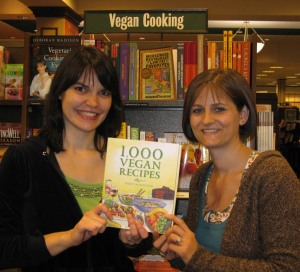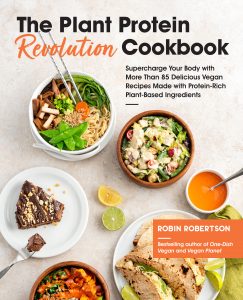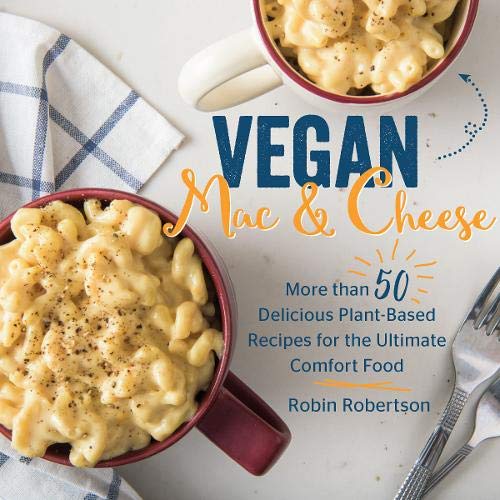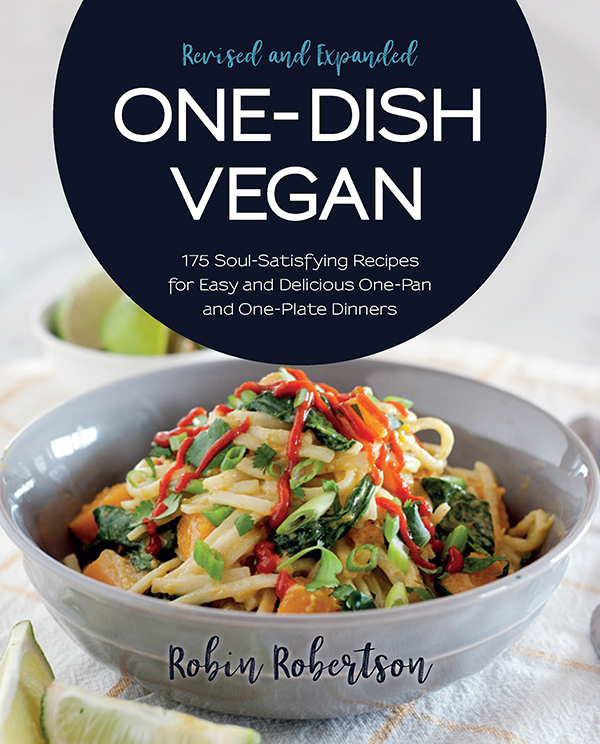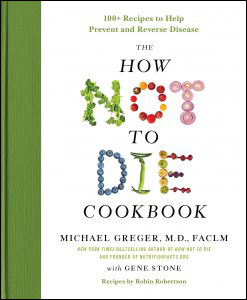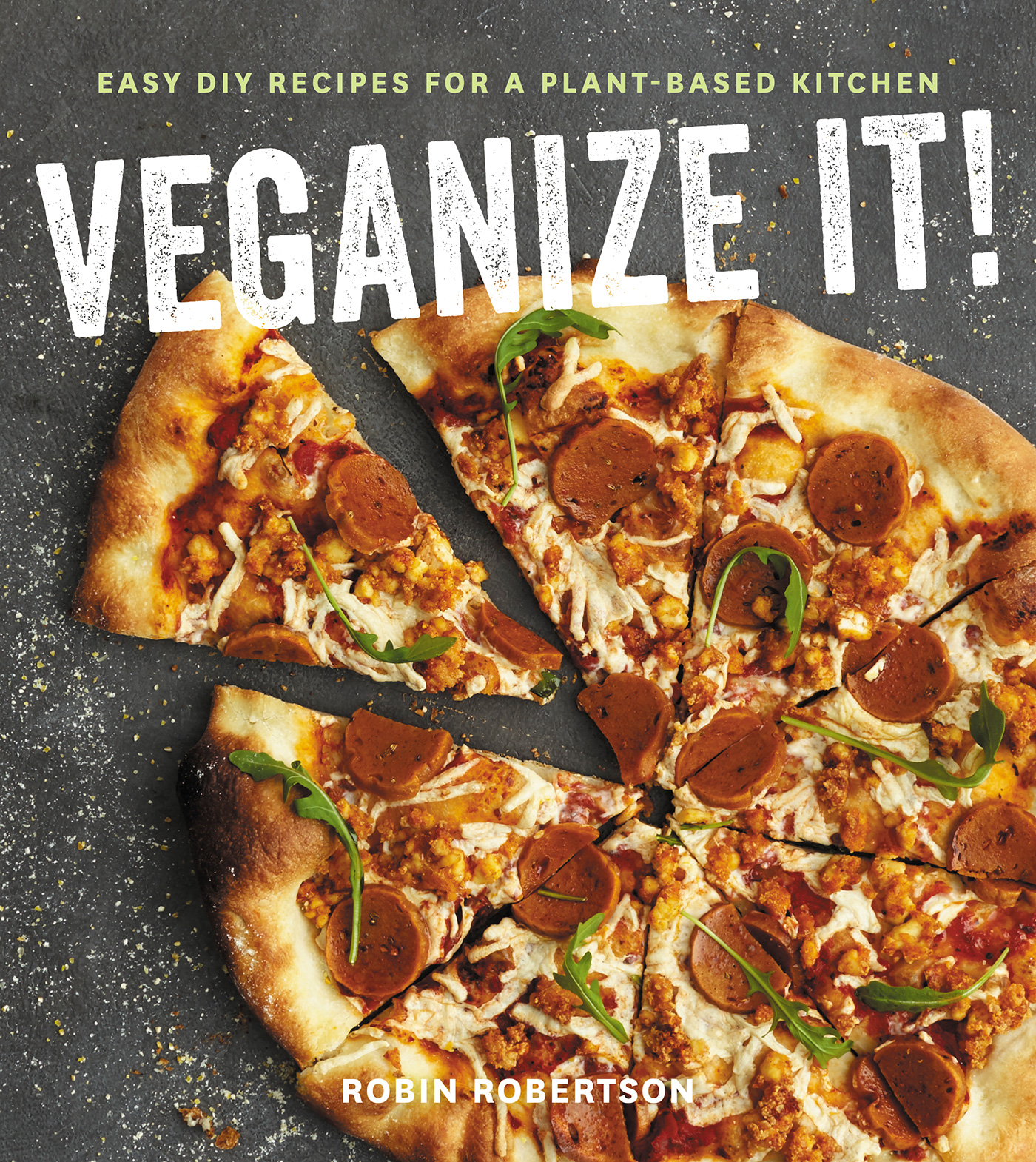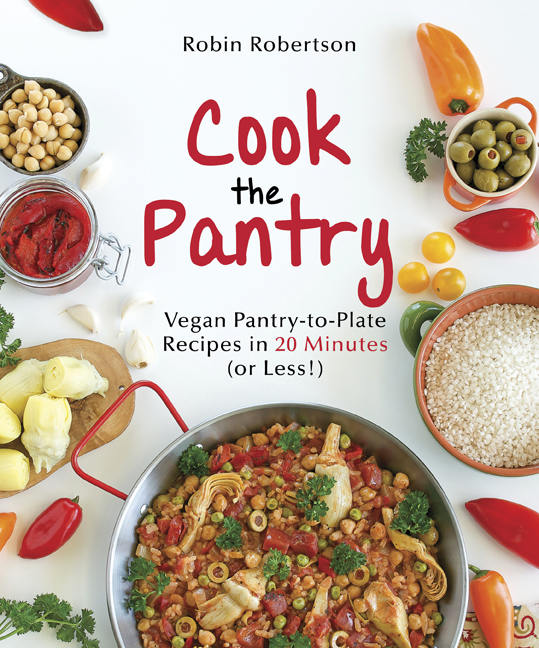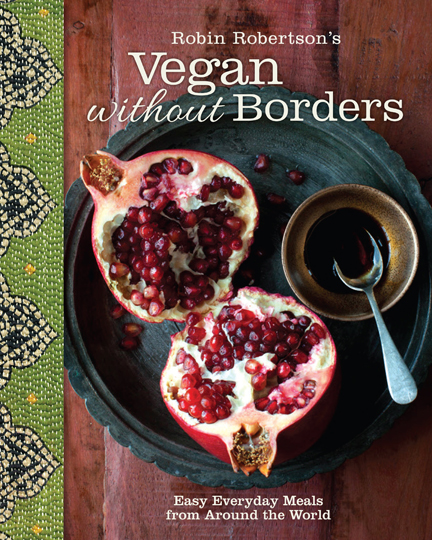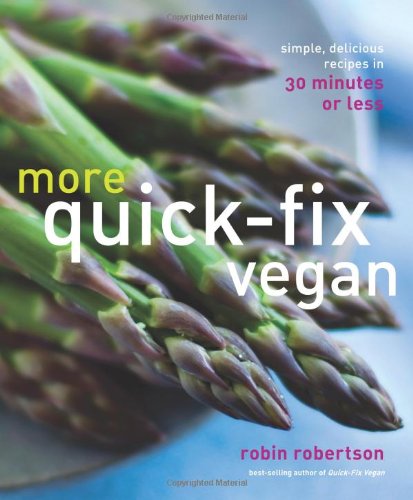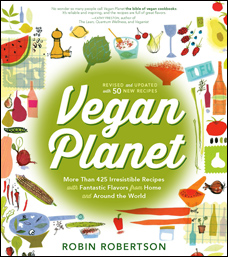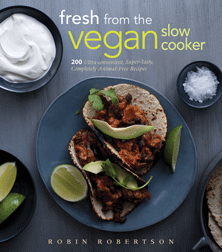Thanks for sending the photo, Lisa! You two are adorable, and I’m happy to see my new book in such good company!
Personally, I enjoy apples when they’re combined with savory foods such as roasting chunks of apple with carrots and potatoes to serve with a seitan roast, or sautéing sliced apples with cabbage, onion, and vegan sausage. Apples are also a great addition to salads, like this spinach salad that combines a chopped apple with figs and toasted almonds tossed with a light vinaigrette. You can use any kind of apple you like in this salad and walnuts or another nut can be substituted for the almonds.
I love the way the varying textures and flavors in this salad play off one another. It’s a great salad for these autumn days when the weather’s still warm enough that a refreshing salad seems like a good idea, but you want one that’s satisfying enough to remind you that it’s autumn.
Spinach Salad with Almonds, Fuji Apple, and Figs
3 tablespoons olive oil
1 1/2 tablespoons white balsamic vinegar
1/2 teaspoon sugar
Salt and freshly ground black pepper
5 cups loosely packed fresh baby spinach
1/2 cup toasted slivered almonds
1/2 cup sliced or chopped figs
1 Fuji apple, peeled, cored, and cut into ¼-inch dice
In a small bowl, combine the oil, vinegar, sugar, and salt and pepper, to taste. Blend well and set aside. In a large bowl, combine the spinach, almonds, and figs. Add the apple along with enough of the dressing to coat. Toss gently to combine.
Like many people, mac and cheese is one of our all-time favorites. And, as most vegans know, it’s one dish that everyone seems to have an opinion about. The main point of departure about what makes a great mac and cheese usually concerns how to get that creamy cheesy flavor without using dairy cheese. There’s the nutritional yeast camp, the tofu faction, and the fans of vegan cheese products. Some people like all three ingredients in their mac and cheese, while others will have none of it.
I personally never met a vegan mac and cheese I didn’t like, but I thought it would be great to see if I could come up with a version that didn’t contain any of those debatable ingredients — and still taste like mac and cheese. The other stipulation I gave myself was to include a green vegetable like spinach or chard in the recipe so it could be served as a one-dish meal — and also seem a little more virtuous, to boot.
The result of my personal challenge is called Mac and Chard. This soy-free, nutritional yeast-free, (and of course cheese-free) version of macaroni and cheese is teamed up with the lovely and healthful addition of chopped rainbow chard. The recipe is from my new book, 1,000 Vegan Recipes, which is now available (a week early!) on Amazon, Barnes and Noble, and Borders.
Mac and Chard
If rainbow chard is unavailable, use another variety of chard or substitute fresh spinach. To make the sauce silky smooth, it is best to use a high-speed blender such as a Vita-Mix to help grind the cashews to a powder. (This recipe is from 1,000 Vegan Recipes published by John Wiley & Sons.)
12 ounces elbow macaroni
1 medium bunch rainbow chard, tough stems removed, and chopped
2 tablespoons olive oil
1/2 cup chopped yellow onion
1 garlic clove, chopped
1 Yukon gold potato, peeled and cut into ¼-inch slices
Salt and freshly ground black pepper
2 cups vegetable broth
1/4 to 1/2 teaspoon turmeric (for color)
3/4 teaspoon sweet paprika
1/2 cup unsalted roasted cashews
1 tablespoon fresh lemon juice
1 teaspoon Dijon mustard
1/2 cup dry bread crumbs (use panko, if you’ve got it)
1. In a pot of boiling salted water, cook the macaroni over medium-high heat until al dente, about 8 minutes. Drain well and set aside.
2. Steam the chard until tender, about 5 minutes. Set aside to cool. When cool enough to handle, squeeze any remaining moisture from the chard and set chard aside. Lightly oil a 9 x 13-inch baking dish and set aside. Preheat the oven to 350° F.
3. In a large saucepan, heat 1 tablespoon of the oil over medium heat. Add the onion, garlic, and potato. Season with salt and pepper, to taste, cover, and cook until the vegetables are softened, about 10 minutes. Add 1 cup of the broth, the turmeric, and 1/2 teaspoon of the paprika, and continue cooking, uncovered, until the vegetables are very soft. Remove from the heat and set aside.
4. Grind the cashews in a high-speed blender until ground to a fine powder. Add the onion and potato mixture, the remaining broth, lemon juice, mustard, and salt and pepper, to taste, and blend until smooth. Taste and adjust seasonings, if necessary.
5. Combine the sauce with the cooked macaroni and steamed chard and transfer to the prepared casserole. Sprinkle with the bread crumbs and remaining 1/4 teaspoon paprika and drizzle with the remaining 1 tablespoon of oil. Bake until hot and golden brown on top, about 30 minutes. Serve immediately.
As expected, the deer ate the lettuce (although we managed to pick a little for ourselves first). What we didn’t expect, was that the deer also ate the tomato plants — they’d never done that before. The cucumber plants produced only enough small cukes to put up two jars of pickles. And the carrots. I didn’t even want to plant carrots this year because I wanted to save room for pricier produce such as arugula which if I didn’t grow it myself, I’d never spend the money on. But Jon wanted homegrown carrots for a carrot cake which he informed me was now a “tradition” since I baked him a cake using our own carrots for two years running.
Trouble is, for all the planting, weeding, and watering, once we dug up the carrots, washed them off, and trimmed them, they were so small this year that there was just enough to make the carrot cake — no more, no less. Jon ate a piece of the cake before we could take the photo, and it really is tasty — moist and delicious with a creamy frosting. And, as it turns out, is well worth growing just enough carrots for.
The recipe is from my latest book, 1,000 Vegan Recipes, which comes out on October 5. The book is available now for pre-order on Amazon, Barnes and Noble, and Borders.
Crazy for Carrot Cake
This carrot cake is moist and flavorful without being cloyingly sweet, with sweet bits of carrot and cloaked in a luscious, creamy frosting. And what a decadent way to get your beta-carotene for the day. For a bit of crunch, add 1/2 cup coarsely chopped walnuts. For an even richer “carrot” color, substitute carrot juice for all or part of the soy milk. This recipe is from 1,000 Vegan Recipes published by John Wiley & Sons.
2 cups all-purpose flour
2 teaspoons baking powder
1 teaspoon baking soda
2 teaspoons ground cinnamon
1/2 teaspoon ground allspice
1 teaspoon salt
1 cup sugar
1/2 cup plain or vanilla soy milk
1/2 cup canola or other neutral oil
1/4 cup pure maple syrup
2 teaspoons pure vanilla extract
2 cups finely shredded carrots
1/2 cup golden raisins (optional)
1 recipe “Cream Cheese” Frosting (recipe follows)
1. Preheat the oven to 350°F. Grease an 8-inch square baking pan and set aside.
2. In a medium bowl, mix together the flour, baking powder, baking soda, cinnamon, allspice, and salt.
3. In a large bowl, combine the sugar, soy milk, oil, maple syrup, and vanilla, then add the wet ingredients to the dry ingredients. Stir in the carrots and raisins, if using, until just mixed.
4. Scrape the batter into the prepared pan. Bake until a toothpick comes out clean, about 45 minutes.
5. Let the cake cool in pan for 15 minutes, then invert onto a wire rack to cool completely. When completely cool, frost the cake with the cream cheese frosting.
“Cream Cheese” Frosting
This frosting is famous for being the crowning glory of carrot cake, but I also like it great on my Banana-Walnut Cake and Spice Cake with Mango and Lime from 1,000 Vegan Recipes.
1 (8-ounce) container vegan cream cheese, softened
2 tablespoons vegan margarine
2 1/4 cups confectioners’ sugar
1 teaspoon pure vanilla extract
1. In a medium bowl, beat the cream cheese and margarine together with an electric mixer on high speed until well blended.
2. Add the confectioners’ sugar and vanilla, then beat until light and fluffy. Store leftovers covered in the refrigerator for up to 3 days.
One treasure I found at this week’s market were the gorgeous chiles you see in the above photo — all of them hot. The farmer was selling them for a dollar a handful, which was a bargain for two reasons — neighboring stands were selling them at five for a dollar, but also, this farmer had huge hands, so his “handful” was extremely generous.
As he dropped two huge fistfuls into a bag, I mentioned that I’d be posting a photo of these fiery little beauties on my blog. He promptly added three more handfuls for free, including some chocolate habaneros — just to add more color to the photo. I came home with a whopping full bag of hot chiles, all for two dollars. Purchased at another farmer’s table, the same amount of chiles would have cost me nearly twenty dollars. And if my own chiles had survived the summer, I never would have met the generous farmer with the aesthetic eye.
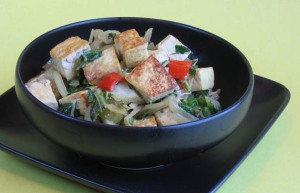
You know you have a great friend when she offers to drive over four hours (each way) to stay at your house and take care of your animals, so you can get away for a few days. When that same friend also brings you a couple cans of the best green curry sauce this side of Thailand, you wish you could clone her.
Incredible but true, my friend Sam did both of these amazing things recently. I came home to an immaculate house, three spoiled but happy cats, and 16 well-fed ducks. Now about that green curry…
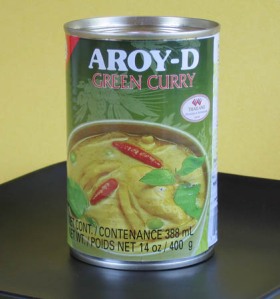 I love a good Thai green curry, but because it’s made with fresh and hard-to-find (for me, anyway) ingredients and with no Thai restaurant nearby, I rarely have a chance to enjoy it. Moreover, I had never found a commercial green curry sauce that had a “wow” effect, until Sam turned me onto a brand she found in Guam — Aroy-D. Although I’ve seen it online ($5.99 shipping for a $2 can of sauce?), neither of us have been able to find it at our regional Asian markets, so the last time Sam went to Guam, she brought home a case of the stuff. And, generous soul that she is, she gave me a couple of cans from her private stash. That stuff is fantastic — as good as any I’ve had in a Thai restaurant. And it’s makes a quick and easy meal that tastes like it took forever to prepare.
I love a good Thai green curry, but because it’s made with fresh and hard-to-find (for me, anyway) ingredients and with no Thai restaurant nearby, I rarely have a chance to enjoy it. Moreover, I had never found a commercial green curry sauce that had a “wow” effect, until Sam turned me onto a brand she found in Guam — Aroy-D. Although I’ve seen it online ($5.99 shipping for a $2 can of sauce?), neither of us have been able to find it at our regional Asian markets, so the last time Sam went to Guam, she brought home a case of the stuff. And, generous soul that she is, she gave me a couple of cans from her private stash. That stuff is fantastic — as good as any I’ve had in a Thai restaurant. And it’s makes a quick and easy meal that tastes like it took forever to prepare.
For the dish you see in the top photo, I stir-fried extra-firm tofu with sliced onion, bok choy, green peas, and a red chile. Once everything was cooked, I simply added the green curry sauce and simmered it for a few minutes, then served it over some brown rice. Mmmm. Thanks again, Sam!

